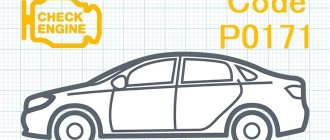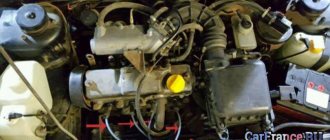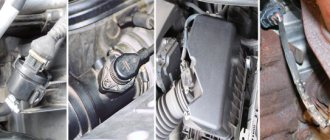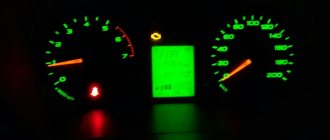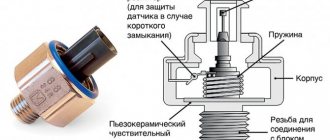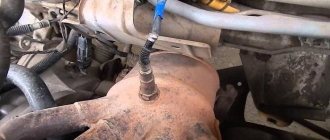The reasons for this error are in many ways a mirror image of the reasons for the appearance of error P0172 in the controller memory.
A lambda probe that degrades over time may physically stop working - that is, deviations in the oxygen balance “from different sides” of the sensitive element will no longer lead to a change in voltage at its terminals (here we are talking about the classic version of a platinum oxygen sensor, which is precisely the source of voltage). For the ECU, this is equivalent to a constantly lean mixture; accordingly, the “fuel supply correction” parameter will begin to constantly go positive.
Technical description and interpretation of error P0171
This diagnostic trouble code (DTC) is a generic powertrain code. Trouble code P0171 is considered a common code because it applies to all makes and models of vehicles. Although the specific repair steps may vary slightly depending on the model.
To operate correctly, the engine must add the right amount of fuel to the amount of incoming air. The correct air-fuel ratio is essential for optimal power and fuel efficiency.
The engine control unit (ECU) uses a number of sensors to determine the amount of fuel that needs to be added. Most often, the ratio of air and fuel in the mixture is determined based on the readings of oxygen sensors by calculating the amount of oxygen and carbon monoxide in the exhaust gases.
The most optimal ratio of air and fuel in the mixture supplied to the engine cylinders is 14.7:1. It is this ratio that is necessary to achieve maximum engine power and optimal fuel consumption.
During normal operation, the ECU monitors the balance between rich and lean mixture. Simultaneously monitoring short-term and long-term fuel balance (STFT and LTFT). Typically the fuel adjustment is 3% of the ideal value. This depends on the current air temperature, coolant and load.
Engine problems such as high fuel pressure, a distorted MAF signal, or a faulty fuel injector can increase fuel consumption. Due to these problems, incorrect airflow data is received, which will result in corrupted data.
The ECU will try to compensate for the imbalance in the fuel mixture. If the control module fails to maintain the 14.7:1 ratio, it will trigger DTC P0171 - Fuel Mixture Too Lean (Bank 1).
Causes of DTC P0171
Since the mixture can be lean due to too much air or not enough fuel, we will look at these two problems separately.
Reasons for the increase in air quantity:
- Vacuum leak (air leak) through lines, intake manifold gaskets, throttle valve, mass air flow sensor, EGR valve, idle air control, vacuum brake booster, etc.;
- malfunction of the mass air flow sensor (MAF);
- oxygen sensor malfunction.
Fuel shortage can be caused by the following factors:
- decreased fuel pump performance;
- dirty fuel pump screen;
- clogged fuel filter and injectors;
- Fuel pressure regulator malfunction.
Symptoms of malfunction
The main driver symptom of P0171 is the MIL (Malfunction Indicator Light). It is also called Check engine or simply “check light”.
They can also appear as:
The severity of the P0171 code is higher than average, so it is recommended to fix the problem as soon as possible. Most likely, with this problem, you will be able to continue your trip, but fuel consumption will increase. And due to poor fuel combustion, problems with the catalyst are possible in the future.
How to reset a check on Kalina yourself
It is not recommended to reset errors yourself if the Lada Kalina check engine light is on. The error information will disappear. In a car service, if something happens to the engine after the reset, they will not be able to determine what kind of malfunction caused the engine to stop working. This means that you will have to completely disassemble the motor. It's an expensive endeavor.
However, if the car owner is sure that the wires were simply shorted after washing the car (this happens), then he can do the following at his own peril and risk:
- Turn the ignition key, but do not start the engine.
- Open the hood and remove the terminal from the positive terminal of the battery.
- Wait about 5 or 10 minutes.
- Reinstall the positive battery terminal. Close the hood.
- Turn off the ignition and turn it on again. Now start the engine and get ready to start driving.
The check lamp should disappear from the panel.
Diagnosis and problem solving
A dirty MAF sensor can skew air intake measurements and therefore skew fuel injection calculations. Next, check the fuel pressure to make sure it is in the correct range. Excessive pressure, due to a faulty pressure regulator or a compressed line tube, will cause more fuel to be injected than the ECU expected.
Check that the ECT and IAT (inlet air temperature) readings are correct. The ECU can pick up blocked sensors, so it's good to check that the ECT and IAT readings are within the normal range.
For example, if the engine is running for half an hour on a hot day, the ECT should show a temperature of about 80°C. If it still reads 0°C, the ECU will richen the air/fuel mixture to compensate, resulting in a rich condition.
Reduced fuel pressure
With the engine running, record the fuel pressure, and then stop the engine. Fuel pressure may drop slightly but should remain stable for at least 10 or 15 minutes.
If fuel pressure continues to drop, you may have a leaking fuel injector, which will result in a rich and possibly non-ignitable condition.
Valve blocking
A faulty valve in the cylinder head dumps unburned fuel into the exhaust gas stream. Check and correct this problem before attempting to correct a rich air/fuel mixture error.
Pay attention to other trouble codes that may be present at the same time as P0171. For example, for VVT (variable valve timing) or ignition system.
Traffic fumes
Check the exhaust system for leaks, especially in front of the first O₂ sensor. Damage can be mechanical, in the form of cracks, or caused by corrosion.
The entry of atmospheric air before this sensor can distort the oxygen content measurements. At the same time, the ECU will try to compensate the mixture and add fuel.
How to find an air leak
First method. It is the simplest, it allows you to find out whether there are any air leaks at all and does not require absolutely any equipment. All we need is just the key for “10”. You need to unscrew the mass air flow sensor from the air filter and pull it out together into the corrugation.
Now we start the engine and, using the palm of our hand, completely block the air inlet into the intake manifold through the mass air flow sensor. The corrugation should shrink from the vacuum and after a couple of seconds the engine will stall. We don’t let go of our hand and listen for where things hiss—this is an extra air leak (more details in the video below).
Second way. Here we need some kind of flammable liquid - gasoline, ether, WD-40, carburetor cleaning fluid, etc. It is best, of course, to use gasoline or ether, they are more natural for engine operation. We fill a syringe with gasoline or take a can of any of the above liquids and spray all the connections of the intake manifold. If any of the connections are not sealed, then the liquid will definitely get inside the manifold and the engine speed, at the same time, should change (either decrease or increase). If the engine does not react in any way, then the connection is sealed, there are no problems with it and you need to look further. Well, if the engine starts to react, consider half the job done. We change the gasket or hose and rejoice that error P0171 has disappeared.
The third method is to use a smoke generator. If you don’t have such a thing in your garage, you can ask your friends for it or make it yourself. There are many options for making smoke generators on the Internet. I chose the simplest and fastest - a smoke generator made from a regular cigarette.
Error 0171 lean mixture causes viburnum
On-board computer error P0171 means that the fuel mixture is too lean. That is, the amount of air supplied does not correspond to the amount of gasoline supplied. As a result, part of the gasoline does not burn in the combustion chamber, but burns out in the manifold or exits through the exhaust system.
Some of the symptoms that accompany error P0171:
Air leak
First of all, check the air leak after the mass air flow sensor. Check how tightly all clamps are tightened. Check connections with soapy water. Air leaks will give themselves away as air bubbles in the solution. If there is a strong air leak, you will hear a characteristic hissing sound.
A good article on how to find an air leak: https://www. drive2.ru/l/10216700/
Mass air flow sensor
If no air leaks are observed, check the air flow sensor (MAF). For information on checking the sensor, read the article How to check the mass air flow sensor. The easiest way to diagnose in case of error p0171 is to disconnect the mark from the sensor while the engine is running. If immediately after switching off the engine operation has leveled off, the engine does not twitch and responds well to gas, it’s time to replace the mass air flow sensor with a new one.
MAP pressure sensor
The pressure sensor can also cause message P0171.
Intake manifold
Make sure that there are no cracks, chips, or missing sealant in the intake manifold where air can get in.
Fuel system malfunction
Check the pressure in the fuel rail at a service station, check the fine filter from the fuel pump.
Many motorists remember how a problem arose on carburetor engines when a lean mixture appeared due to the carburetor or filters, which not only slowed down the engine, but also increased consumption (consumption rates). With the development of the automotive industry, the reasons for the effect have become more numerous, since many new details have been added that regulate this indicator. No, all motorists know why a lean mixture can appear on a VAZ-2112, and even more so, how to solve this problem.
Causes of excess air
If, after carrying out this work, instability is also observed in the operation of the system, pay attention to possible places where excess air occurs, since it also affects the leanness of the mixture and the main reasons lie in the following:
- Presence of dirt or marks on the mass air flow sensor.
And in order to eliminate the above reasons, it is necessary to conduct a thorough diagnosis.
Troubleshooting
Mass air flow sensor - the air flow sensor can become clogged due to natural reasons, as well as from vapors that come from the throttle valve while the car is not running. And then, over time, accumulating in a thick layer on the thin thread of the sensor, forcing it to send inaccurate data to the ECU, which in turn negatively affects the parameters of air flow and flow into the system.
When diagnosing its malfunction, it is best not to rush into purchasing, since it costs a lot of money, but it is best to check its performance on a known working device. And when it is established that the reason lies in it, then you can try to clean it, or then replace it with a new one.
Vacuum leak
Vacuum leak - these words mean any form of air leaks, i.e. suction into the system, primarily through the manifold gasket or hoses.
The vacuum pump and return hose may cause
Pay attention to the condition of the pipe leading from the air filter to the throttle valve, and the hoses that go to the crankcase ventilation. There should be no visible damage to them, as well as large cracks through which excess air could enter.
In addition to all of the above, you can check the engine oil dipstick and the oil filler cap on the neck, because if these connections are not completely closed, they can cause the appearance of that same excess air.
Causes of a lean mixture
How to determine the problem of the occurrence of a lean mixture effect in the engine cylinders? There are several reasons why this process may occur. So, let's look at all the possible options:
Now that all the reasons have been considered, you can move directly to elimination methods.
Making a poor mixture into a good one!
To eliminate the causes of a lean mixture, you will have to work hard, since there are quite a lot of components in which a malfunction could occur. It is worth considering the sequence of actions to find the problem area and eliminate the cause.
Problems in the ECU
The first place you need to look is the electronic control unit of the engine and its systems. Thus, the accumulation of errors in the ECU can lead not only to changes in the mixture, but also to other malfunctions. In order to eliminate the cause, you need to connect to the unit using a USB-Auto cable and look for any faults. Often, this is where the initial answer to the question lies. This or that error will show which node caused the malfunction. As practice shows, this may be one of the sensors.
If, however, a large number of errors are detected during connection, then a reset is necessary. If it does not help, and the sensors are all working, then motorists recommend reinstalling the car software. It depends on the type of control unit that is installed on the vehicle.
Self-diagnosis and reset of ECU errors on the instrument panel
Sensors and electronics
Failure of one of the sensors can result in a lean mixture. So, exactly what indicators need to be checked for performance in engines:
Mass air flow sensor
The IAC sensor is located on the throttle valve
Throttle position sensor
After checking all these products, you need to connect to the computer and reset the errors.
It is also recommended to check the wires that go to the sensors for breakdowns. If necessary, damaged elements must be replaced and the error reset procedure repeated.
Fuel system
One of the main systems that leads to a lean mixture is the fuel system. The main reason is insufficient pressure in the fuel rail. This may be due to several reasons:
Mesh filter installed in the fuel module
Checking the fuel pump by immersion in water
Sectional view of the fuel filter after removal from the vehicle
Cleaning injectors without removing them from the car
Throttle
If the problem does not go away when repairing the fuel system, then you need to pay attention to the air supply system to the engine. So, the cause of a lean mixture may be a clogged throttle valve or air filter.
To diagnose, you need to remove the filter element from its seat and inspect it. The presence of oil stains may indicate poor performance of the valve stem seals. A large accumulation of dust causes it to not allow air to pass through in the required amount. To fix the problem, you need to replace the element. The throttle also needs to be dismantled and inspected. If there is too much blockage, clean it with WD-40.
Ignition system
The last system where a lean mixture could be caused is the ignition system. So, it is necessary to diagnose the following elements:
Characteristics of different spark plugs
Injector problems
You don't have to be an expert to understand that the problem here lies in the operation of the injector. And first of all, before we start studying lean mixture, let’s try to find out what it even is. This is important only because such a reason can lead to expensive repairs to the car.
Why do jerks happen?
The presence of jerks while the car is moving is a problem that directly or indirectly indicates the presence of problems with the engine, or more precisely, a loss of power. In total, there are two features that affect the development of power in the engine - fuel supply and the ignition system.
If with the ignition, everything is more or less clear, due to the inspection of the generator, spark plugs, ignition wires for faults, and the battery for charge, then in the case of the ignition system everything looks much more complicated.
High voltage wires are marked with arrows
Inspecting the condition of the spark plugs
To ensure a successful engine start, it is necessary to mix the fuel and air mixture in ideal proportions; this is what the injector is responsible for.
It happens that when mixing these proportions, a malfunction occurs, and the mixture turns out to be rich or lean.
A clear example of the air-fuel mixture ratio.
In order for the car to obtain maximum power when burning fuel in the cylinders, it is necessary to bring its indicator to the level of 0.85 - 0.9, when excess oxygen = > 1 (at this indicator, gasoline burns completely without residue - approx.), and when there is a lack of oxygen, and the readings are equal. The main reasons for a lean mixture
The main and most important symptom that the system has a lean mixture is a stalling or unstable engine. And if the mixture is very poor, then it is possible that it will not start at all.
The cause of these problems is most often a clogged air filter (see “replacing the air filter”), clogged injectors, wear in the fuel pump, and there may also be air leaks into the system. All these reasons are, one way or another, related to the stable operation of the engine.
What do spark plugs tell us?
One of the fundamental checks for the condition of the mixture will be to assess the condition of the spark plug.
So, a light brown tint will indicate that the system is operating normally, a too dark tint will indicate a lack of (enriched mixture - approx.), too light, an excess (depleted - approx.) mixture.
conclusions
It is quite easy to establish the cause of a lean mixture on a VAZ-2112, and knowing it, you can eliminate it. Of course, not all motorists are able to make repairs themselves. Therefore, if you are not sure that you can handle it, we recommend that you contact a car service, where they will do everything efficiently and quickly. Not always true!
The reasons for this error are in many ways a mirror image of the reasons for the appearance of error P0172 in the controller memory.
A lambda probe that degrades over time may physically stop working - that is, deviations in the oxygen balance “from different sides” of the sensitive element will no longer lead to a change in voltage at its terminals (here we are talking about the classic version of a platinum oxygen sensor, which is precisely the source of voltage). For the ECU, this is equivalent to a constantly lean mixture; accordingly, the “fuel supply correction” parameter will begin to constantly go positive.
First aid for a car with error P0172
The first thing that should be eliminated if the injector prepares a rich mixture is to abandon all kinds of additional settings for the volume of supplied air or fuel. The vehicle's fuel system may have been adjusted. If this is the case, it is necessary to cancel these adjustments, since prolonged operation of the engine on a rich mixture can lead to breakage of the pistons and failure of the spark plugs.
The second common reason for the formation of a rich mixture is incorrect fuel supply from the injectors. You can suspect injectors if there are traces of fuel assembly combustion on the outside of the injector. Traces of fuel assembly combustion can also be found on one side of the copper O-ring. If such signs are found, you need to check whether the injector is installed correctly and whether the o-ring is in place.
Error p0172
The third undeservedly ignored reason is air filter contamination. If the filter is heavily clogged, the pressure in the cylinders increases, and as a result, incorrect preparation of fuel assemblies occurs.
The fourth reason for preparing a rich fuel assembly is incomplete closing of the air damper/valve. In this case, the pressure in the cylinders is reduced and this, again, leads to errors in the preparation of fuel assemblies and disruption of the functioning of the internal combustion engine systems: the injectors begin to pour more fuel, increasing consumption and reducing power.
If the fuel pressure regulator does not fully function on its own, then the errors here are the same as in the previous two cases: increased or decreased pressure in the cylinders.
The sixth group of reasons is not so common. Problems with the air flow sensor, the fuel vapor recovery system, or problems with the economizer are often a consequence. However, if all the previous reasons have been eliminated, but the problem remains, you should check this group of reasons. If the problem really lies with them, then it will be solved by simply replacing these parts.
It should be noted that 90% of errors can be solved by simply adjusting the liquid fuel injection. The main thing here is to fix the problem in time, before the injector breaks and other problems arise: for example, pistons may become unusable, spark plugs may burn out, etc.
The engine stalls, the check light flashes or lights up: the main reasons
Let's start with the fact that injection engines are equipped with special catalyst devices for cleaning the exhaust. At the same time, the catalytic converter is a rather vulnerable and at the same time expensive element, and all sorts of malfunctions in the engine create a risk of damage.
As a rule, the check flashes when there is a risk of damage to the catalyst. In this case, the simultaneous tripping of the engine means that one or more cylinders are not working or are not working correctly. In practice, this means that the fuel in the problem cylinder does not burn completely, after which it enters the exhaust system.
As a result, the remaining unburnt fuel burns out in the area where the catalyst is located, since the temperatures there are very high. Fuel also gets on the catalyst itself, causing it to fail.
It should be added that the check also often lights up in the event of failure of any ECM sensors. One way or another, it is quite obvious that the “check” in the vast majority of cases indicates either problems with the electronic engine control system itself, or the risk of damage to the catalyst due to malfunctions of the internal combustion engine.
It is important to understand that the engine tripping indicates a non-functioning cylinder. In this case, the check is flashing not due to the failure of any ECM sensor, malfunction of the exhaust gas recirculation system or poor fuel in the tank, but rather signals to the driver about a direct threat to the catalyst
In a nutshell, fuel that is not burned and gets into the outlet causes a special sensor (lambda probe, oxygen sensor) to send readings to the ECU indicating deviations from the norm. The control unit begins to try to correct the situation, but taking into account the tripping, it is simply not able to adjust the operation of the motor so that everything returns to normal. As a result, fuel consumption increases, while the engine operates unstably, idle speed fluctuates, etc. In some cases, the motor “falls” into emergency mode.
This feature of engine operation is primarily aimed at preventing burnout or melting of the catalyst. The catalyst itself consists of small honeycomb cells. If unburned fuel intensively enters the exhaust and burns out in the catalyst, the element will simply melt.
This melting will lead to the fact that exhaust gases will not be able to pass normally through the catalyst, that is, a plug appears in the exhaust pipe. Naturally, the engine will “suffocate”, power will drop, the engine may not start at all, etc.
Also, the catalyst will no longer be able to clean the exhaust, and toxicity will increase. There is only one way out in this situation - repairing the engine to eliminate the main cause of the engine tripping, and only then replacing the expensive catalyst with a new one. To minimize risks, a special program is programmed into the ECU, which involves operating the engine in emergency mode.
avtoexperts.ru
I had to personally face such a problem as a lean mixture and find out all the reasons. Therefore, I want to tell you from personal experience what to pay attention to first. Today we will learn at the beginning what a lean mixture actually is and how it affects the engine. We will also find out what signs and causes it is accompanied by.
What it is?
First you need to understand the difference between a rich and lean mixture. So, everyone understands perfectly well that fuel consists not only of “fuel”, but also of a certain proportion of air. Depending on the mode, type of operation of the internal combustion engine and a host of other factors, mixing of the listed components can be done in different proportions. If you take average portions, then it is within 1 kg. gasoline for 14-15 kg. air. That is, these are average indicators at which the motor operates stably.
But, if, for example, the amount of air is reduced, say to 12 kg, then the proportion of gasoline increases accordingly. But, at the same time, power and fuel consumption increase. If you reduce the amount of air further, the mixture becomes enriched, that is, rich.
In the case when the amount of air increases, we observe the opposite effect when the fuel mixture becomes lean. Accordingly, power is reduced and fuel consumption is reduced.
That is, a lean mixture is when:
Signs of a lean mixture
There are actually many signs, and they may even resemble problems associated with other nodes. So, we can highlight:
• Unstable idle operation. Here you should also pay attention to the idle air control, it may be clogged, etc.
• When trying to move away, the internal combustion engine stalls.
• When you press the accelerator pedal, there is no reaction or it is very weak.
• The motor does not pull even without load.
For example, if you take carburetor cars, the car often begins to “sneeze” if the mixture is lean. Popping noises occur at the injectors and explosions occur in the exhaust system.
In addition, the color of the candles will help determine which mixture, normal, lean, or vice versa, rich. But there is a nuance here; this is determined only on injection engines. For example, if the color of the spark plugs is brownish, then the internal combustion engine is in order. But, if the shade is light, white, it indicates that there is too much air in the fuel mixture, which means the mixture is lean.
If the color of the candles is dark, but on the contrary there is a lack of air.
But the exact cause is difficult to determine only by soot. In addition, carbon deposits may indicate that the ignition is not set correctly; that’s another question. In general, a pattern has long been noticed among motorists: if the pops in the exhaust manifold are short and seemingly single, then this indicates a rich mixture. But if the explosions and pops are long and frequent, then it’s definitely a poor mixture. If the latter, then the car will begin to stall, jerk, and may not start at all.
Causes and diagnosis
When computer checking a car, the scanner often records an error such as a lean mixture under code P0171. Error codes from various sensors may also indicate problems with fuel generation. So what causes more air or less fuel?
1. Air sensor, also known as mass air flow sensor.
First of all, you need to pay attention to all kinds of sensors. Most often, problems with a lean mixture appear when the mass air flow sensor is simply clogged or “died.” For example, if it is contaminated, then the “brains” react to the readings with a slowdown, which is why an incorrect “command” is sent to the injectors to supply air in an increased volume. As a rule, the ECU reacts to malfunctions with the mass air flow sensor if, over a certain period of time, the supply of more air was noticed. For example, the error code on domestic Ladas is P0103.
2. Problems with the EGR valve.
This valve is responsible for returning a certain amount of exhaust gas to the cylinder. The valve receives signals from the ECU, which, in turn, receives and analyzes readings from the coolant temperature sensor, oil pressure, throttle sensor, intake manifold temperature sensor, etc. That is, if any of the sensors listed above provides incorrect data, the ECU may interpret this incorrectly and send a signal to the EGR valve, which will cause the latter to open for a longer time and add more exhaust gases than necessary. But often the reason is more banal: the valve is broken, clogged, which is why it does not work correctly. Error code PO404.
3. Problems with the intake system, malfunction of the throttle position sensor (TPS).
Diagnose the throttle valve; it may be dirty or not working correctly. Remember that the position of the damper must correspond to the temperature of the engine (if the damper is automatic) or the position of the gas pedal. On a hot internal combustion engine, the damper should be open, on a cold one it should be turned at a certain angle, depending on the model of the car. Accordingly, if the damper is not working correctly, then the air damper is generating the wrong amount of air. Check the TPS, error code is P2135.
